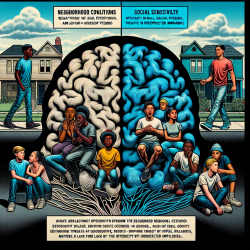Understanding the Intersection of Neighborhood Disadvantage and Neural Sensitivity
Recent research titled "Neighborhood disadvantage, race/ethnicity and neural sensitivity to social threat and reward among adolescents" explores how neighborhood environments impact adolescents' neural processing of social threats and rewards. This study provides critical insights for practitioners, particularly those working with diverse populations in educational and therapeutic settings, such as TinyEYE's online therapy services for schools.
Key Findings and Implications for Practice
The study utilized a diverse sample of adolescents to examine how neighborhood disadvantage intersects with racial/ethnic background in shaping neural responses. The findings revealed that:
- Neighborhood disadvantage was linked to greater neural activation in regions associated with salience detection and mentalizing, particularly for Black and Latine youth.
- Black youth showed heightened neural responses to both social threats and rewards in disadvantaged neighborhoods, indicating a potential resilience or adaptive response.
- Latine youth exhibited increased activation in mentalizing regions, suggesting a heightened awareness of social cues and potential threats.
These findings underscore the importance of considering the social environment and racial/ethnic background when assessing and planning interventions for adolescents. Practitioners should be aware of how these factors may influence children's social and emotional development and tailor their approaches accordingly.
Encouraging Further Research and Application
The study highlights the need for further exploration into how different social experiences, including systemic and interpersonal racism, influence neural development. Practitioners are encouraged to stay informed about ongoing research in this area and consider how these insights can be integrated into their practice to improve outcomes for children.
By understanding the nuanced ways in which neighborhood disadvantage affects neural processing, practitioners can develop more effective, culturally responsive interventions that address the unique needs of diverse populations.
Conclusion
This research provides valuable insights into the complex interplay between neighborhood environments, race/ethnicity, and neural sensitivity. By applying these findings, practitioners can enhance their ability to support adolescents in overcoming challenges associated with social threats and rewards.
To read the original research paper, please follow this link: Neighborhood disadvantage, race/ethnicity and neural sensitivity to social threat and reward among adolescents.










